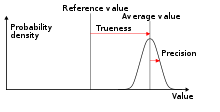
Back الدقة والضبط Arabic Dəqiqlik Azerbaijani সঠিকতা ও সূক্ষ্মতা Bengali/Bangla Exactitud i precisió Catalan Přesnost a preciznost Czech Тĕллĕх CV Genauigkeit German Ekzakteco kaj precizeco Esperanto Precisión y exactitud Spanish Täpsus ja kordustäpsus Estonian

Accuracy and precision are two measures of observational error. Accuracy is how close a given set of measurements (observations or readings) are to their true value. Precision is how close the measurements are to each other.
The International Organization for Standardization (ISO) defines a related measure:[1] trueness, "the closeness of agreement between the arithmetic mean of a large number of test results and the true or accepted reference value."

While precision is a description of random errors (a measure of statistical variability), accuracy has two different definitions:
- More commonly, a description of systematic errors (a measure of statistical bias of a given measure of central tendency, such as the mean). In this definition of "accuracy", the concept is independent of "precision", so a particular set of data can be said to be accurate, precise, both, or neither. This concept corresponds to ISO's trueness.
- A combination of both precision and trueness, accounting for the two types of observational error (random and systematic), so that high accuracy requires both high precision and high trueness. This usage corresponds to ISO's definition of accuracy (trueness and precision).[2]
- ^ Cite error: The named reference
iso5725was invoked but never defined (see the help page). - ^ Menditto, Antonio; Patriarca, Marina; Magnusson, Bertil (2007-01-09). "Understanding the meaning of accuracy, trueness and precision". Accreditation and Quality Assurance. 12 (1): 45–47. doi:10.1007/s00769-006-0191-z. ISSN 0949-1775.